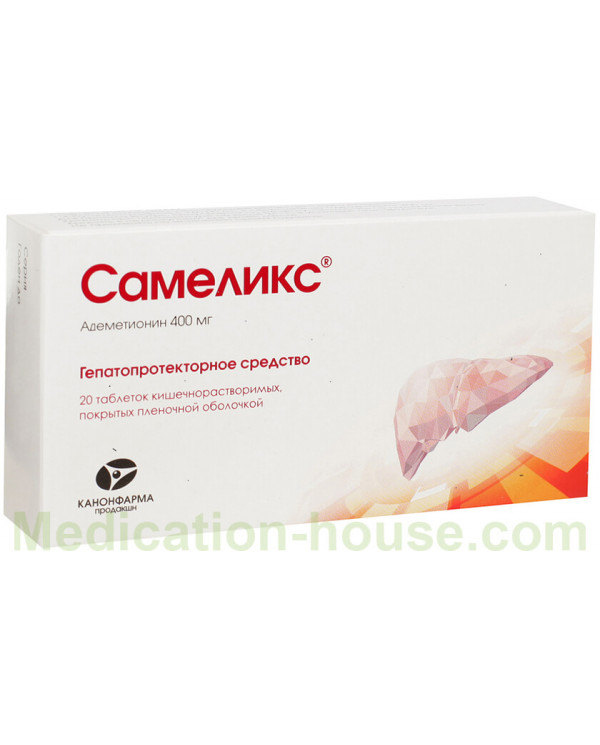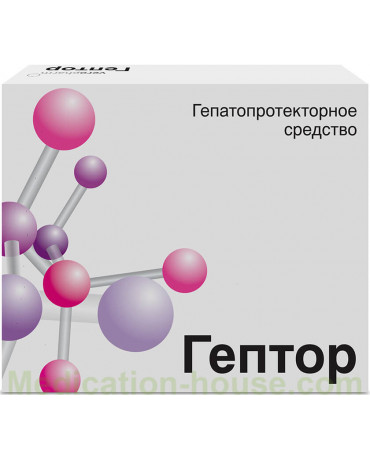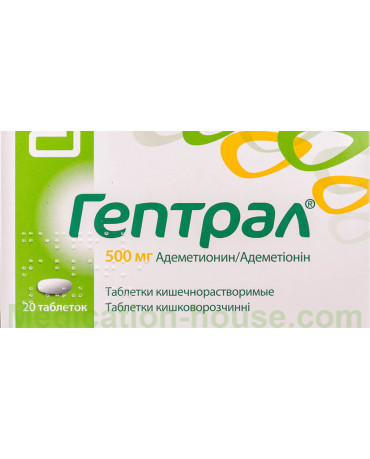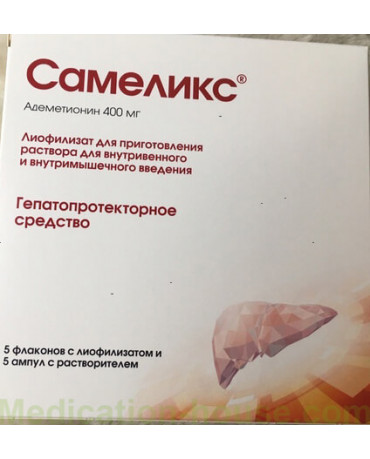Release form and composition
The drug is available in the following dosage forms:
enteric-coated tablets, film-coated: biconvex, oval, white or almost white (10 pcs. in blisters, in a cardboard bundle of 1, 2 or 4 blisters, along with instructions for medical use);
Composition per enteric-enteric film-coated tablet:
active substance: ademethionine (as 1,4-butanedisulfonate ademethionine) - 400 mg;
auxiliary components of the tablet core: colloidal silicon dioxide, microcrystalline cellulose, sodium carboxymethyl starch, magnesium stearate;
film coating: Transparent opadray (polyethylene glycol, hypromellose), Acrylic-IZ white (talc, sodium bicarbonate, titanium dioxide, colloidal silicon dioxide, sodium lauryl sulfate, copolymer 1 ÷ 1 methacrylic acid and ethyl acrylate); triethyl citrate.
Pharmacodynamics
Ademethionine is a hepatoprotector. It also has antidepressant properties. It has a choleretic and cholekinetic (enhancing the excretion of bile) effect. It has antioxidant, regenerating, detoxifying, neuroprotective and anti-fibrosing activity. Compensates for the lack of S-adenosyl-L-methionine in the body and stimulates its production. Ademethionine is found in all media and body tissues, but its highest concentrations are found in the brain and liver.
Ademethionine plays a crucial role in the metabolic processes occurring in the body, in particular, it is involved in biochemical reactions (transamination, transmethylation and trans sulfation). In the trans sulfation reactions, it is the precursor of taurine, cysteine, and glutathione (which provides the redox mechanism of cell detoxification), as well as coenzyme A (thereby, being included in the biochemical reactions of the Krebs cycle and replenishing the energy reserves of the cell). In transmethylation, he donates a methyl group for the subsequent synthesis of nucleic acids, neurotransmitters, phospholipids of cell membranes, hormones, proteins, etc. Ademethionine increases the concentration of taurine and cysteine in blood plasma, increases the amount of glutamine in the liver; reduces the serum concentration of methionine, normalizing hepatic metabolism. After decarboxylation, ademethionine takes part in aminopropylation reactions, as it is a precursor of polyamines that enter the structure of ribosomes (spermine, spermidine and putrescine).
Samelix normalizes the synthesis of phosphatidylcholine in the liver cells, which increases the polarization and fluidity of the membranes. Due to this, the function of transport systems of bile acids is improved and their passage to the biliary tract is accelerated. Especially effective for intralobular cholestasis. Ademethionine reduces the toxicity of bile acids in liver cells, as it carries out their sulfation and conjugation. Due to conjugation with taurine, the solubility of bile acids increases and their excretion from hepatocytes is accelerated, and due to sulfation, the excretion of bile acids by the kidneys becomes possible. In addition, sulfated bile acids provide additional protection for hepatocyte cell membranes from the toxic effects of non-sulfated acids, which are found in high concentrations in the hepatocytes of patients with intrahepatic cholestasis.
In diffuse liver diseases (hepatitis, cirrhosis) with intrahepatic cholestasis syndrome, the drug reduces the severity of skin itching, as well as the degree of changes in biochemical parameters (activity of aminotransferases and alkaline phosphatase, direct bilirubin level). Hepatoprotective and choleretic effects persist up to 3 months after discontinuation of therapy.
The drug also exhibits its therapeutic properties in liver diseases caused by various hepatotoxic drugs. When the drug is prescribed to patients with opioid addiction, which is accompanied by liver damage, a regression of clinical symptoms of withdrawal is observed, microsomal oxidation processes and the general functional state of the liver improve. The antidepressant effect is manifested gradually: the first changes are noted at the end of the first week of therapy and stabilize within two weeks.
The drug is effective in regularly recurring neurotic and endogenous depressions that are not amenable to treatment with amitriptyline. Samelix is able to interrupt relapse of depression.
Finally, ademethionine increases the synthesis of proteoglycans, which leads to partial restoration of cartilage.
Pharmacokinetics
Samelix tablets are coated with a special enteric coating. Due to this, the release of the active substance occurs only in the duodenum. When administered, the bioavailability of ademetionine is 5% (when taken on an empty stomach, this indicator increases). The maximum plasma concentrations are dose-dependent and are 0.5–1 mg / L 3–5 hours after taking Samelix at a dose of 400–1000 mg once. The maximum concentration of the drug in plasma is reduced to its original value within 24 hours.
With parenteral administration, the bioavailability of the active substance is 96%, and the maximum plasma concentration is observed after 45 minutes.
About 5% of ademetionine binds to plasma proteins. The drug passes through the blood-brain barrier. Its concentration in the cerebrospinal fluid increases significantly.
Metabolism occurs in the liver. The drug enters the so-called ademethionine cycle. At the first stage, S-adenosyl homocysteine is formed from ademethionine under the action of ademethionine-dependent methylases, which, using S-adenosyl homocysteine hydrolase, is hydrolyzed to adenosine and homocysteine. Homocysteine is transformed to methionine, which can eventually be converted back to ademethionine.
The drug is excreted by the kidneys. The half-life is 1.5 hours.
In studies involving healthy volunteers who ingested labeled (methyl 14C) S-adenosyl-L-methionine, 48–17% of radioactivity was found in urine after 48 hours, and after 72 hours, an isotope in the amount of 23–28% of the dose was detected in feces. Based on them, it was concluded that about 60% of ademetionine is deposited.
Indications for use
Samelix is used in patients with intrahepatic cholestasis in cirrhotic and precirrotic conditions that are a consequence of diseases / conditions such as:
chronic hepatitis;
fatty liver disease;
cirrhosis of the liver;
chronic non-calculous (stoneless) cholecystitis;
encephalopathy, including encephalopathy associated with liver failure (e.g., alcoholic);
inflammation of the bile ducts;
toxic liver lesions of various origins, including viral, alcoholic and medicinal (occurring when taking antiviral and anti-tuberculosis drugs, oral contraceptives, antibiotics, tricyclic antidepressants, antitumor drugs).
In addition, Samelix is indicated for intrahepatic cholestasis in pregnant women, and it is also prescribed for patients with symptoms of depression.
Contraindications
Absolute:
genetic disorders that cause hyperhomocysteinemia and / or homocystinuria and / or affect the methionine cycle (for example, a violation of the metabolism of cyanocobalamin, a deficiency of the enzyme cystathionine beta-synthase);
children and adolescents under 18 years of age;
increased individual sensitivity to the main or auxiliary components of the drug.
Relative (Samelix is used with caution):
renal failure;
bipolar disorder;
co-administration with herbal preparations, tricyclic antidepressants (clomipramine), tryptophan-containing drugs and SSRIs (selective serotonin reuptake inhibitors);
first trimester of pregnancy;
lactation period;
elderly age.
Instructions for use: method and dosage
Samelix tablets are taken orally, not with meals (preferably in the morning). The tablet should not be chewed, but should be swallowed whole, washed down with water.
It is forbidden to take the drug if the integrity of the blisters is broken and the tablets have acquired a color different from white or white with a slight yellowish tint.
The recommended initial dose is 10–25 mg / kg body weight per day. With intrahepatic cholestasis, 800-1600 mg per day are prescribed. A similar dose is used for symptoms of depression.
The duration of the course of treatment is determined by the doctor. At the beginning of treatment, the use of a parenteral form of ademetionine is possible. Subsequently, the patient is transferred to the drug in the form of tablets.
Side effects
The most common adverse reactions identified during the studies are nausea, headache and diarrhea.
Other side effects established during clinical trials and observed with the post-marketing use of Samelix:
gastrointestinal tract: often - nausea, loose stools, abdominal pain; infrequently - vomiting, dry mouth, dyspeptic and gastrointestinal disorders, gastrointestinal pain, flatulence, gastrointestinal bleeding; rarely - esophagitis, bloating;
cardiovascular system: infrequently - lowering blood pressure, flushing of the skin;
respiratory system: infrequently - laryngeal edema;
nervous system and psyche: often - insomnia, headache, anxiety; infrequently - dizziness, confusion, agitation, paresthesia;
musculoskeletal system: infrequently - muscle cramps, arthralgia;
skin and subcutaneous fat: often - itchy skin; infrequently - urticaria, rash, erythema, increased sweating, Quincke's edema;
immune system: infrequently - anaphylactic or anaphylactoid reactions (including bronchospasm, shortness of breath, changes in blood pressure, chest discomfort, bradycardia or tachycardia, hyperemia of the skin, back pain);
parasitic and infectious diseases: infrequently - urinary tract infections;
other reactions: infrequently - chills, fever, swelling, asthenia; rarely - malaise.
Overdose
The likelihood of an overdose is very small. If such a situation arises, it is recommended that patient monitoring be established. The treatment is symptomatic.
Special instructions
Samelix has tonic properties, so it should not be taken before bedtime.
In patients with cirrhosis of the liver on the background of hyperazotemia during treatment, it is necessary to systematically determine the nitrogen content in the blood. With prolonged therapy, it is required to control the level of creatinine and urea in the blood serum.
Samelix is used with caution in patients with bipolar disorders, as in patients who took ademetionine, individual cases of the transition of depression to mania or hypomania have been reported.
People with depression have an increased risk of suicidal behavior / thoughts and suicide, therefore, during the treatment with the drug, such patients require constant monitoring. It is necessary to regularly evaluate the effectiveness of the treatment, and also inform the doctor if the symptoms of depression do not decrease or worsen.
In patients who take ademetionine, anxiety may suddenly appear or increase. Usually, in such cases, the withdrawal of Samelix was not required, but sometimes the anxiety disappeared only after a dose reduction or a complete cessation of therapy.
During treatment, it is necessary to control the content of vitamins in the blood, especially in patients who are at risk (vegetarians, pregnant women, patients with anemia or liver disease, following a diet, etc.). This is due to the likelihood of lowering the level of ademetionine with a deficiency of folic acid and vitamin B12. If deficiency is identified, it is recommended to start taking folic acid and vitamin B12 before starting therapy with Samelix or simultaneously with it.
It should be borne in mind that taking ademetionine can distort the result of an immunological analysis to determine homocysteine (the level of homocysteine in the blood will be overestimated). Other (non-immunological) analysis methods are recommended.
One vial with lyophilisate contains 6.61 mg of sodium. This amount of sodium is equivalent to 16.8 mg of sodium chloride (0.3% of the maximum recommended daily intake of sodium for an adult).
Influence on the ability to drive vehicles and complex mechanisms
One of the side effects of Samelix is dizziness, so before determining an individual reaction to the drug, it is not recommended to drive a car and perform other work that requires a high concentration of attention and a quick reaction.
Pregnancy and lactation
Clinical studies have shown that ademetionin is safe in the third trimester of pregnancy.
The effectiveness and safety of Samelix in the first and second trimesters, as well as during breastfeeding, has not been studied, therefore, its use during these periods is possible only after a thorough assessment of the expected benefits to the mother and the potential risk to the fetus or child.
Use in childhood
Samelix is not used in pediatric practice (in children and adolescents under 18 years of age), since the experience of medical use in this age group is limited.
With impaired renal function
The drug is prescribed with caution to patients with renal failure.
With impaired liver function
The pharmacokinetics of ademetionine in individuals with chronic liver diseases and in healthy volunteers does not differ, therefore, there are no restrictions on the use of Samelix in patients with impaired liver function.
Drug interaction
Samelix is used with caution simultaneously with clomipramine, SSRIs, drugs and herbs containing tryptophan, since the occurrence of an excess serotonin syndrome is possible. No other drug interactions have been reported.
Terms and conditions of storage
Store in the original packaging at a temperature not exceeding 25 ° C. Keep out of the reach of children.
Shelf life is 2 years.
Reviews
According to reviews, Samelix is an effective hepatoprotector and protects the liver from the toxic effects of various drugs, viral agents and alcohol. Acts fast enough. The first improvements were noted after a week of taking the pills. The effect is cumulative and persists for several months after discontinuation of therapy. Samelix is cheaper than some similar products.
Terms of sell
You can buy Samelix without a prescription.




